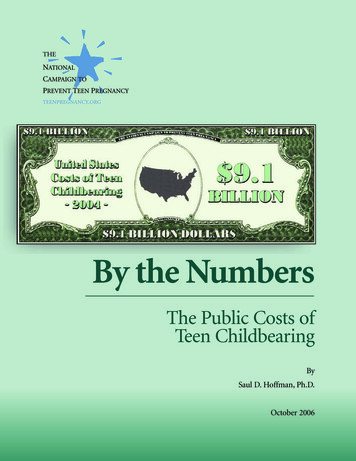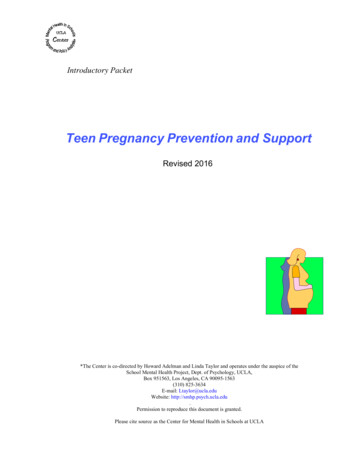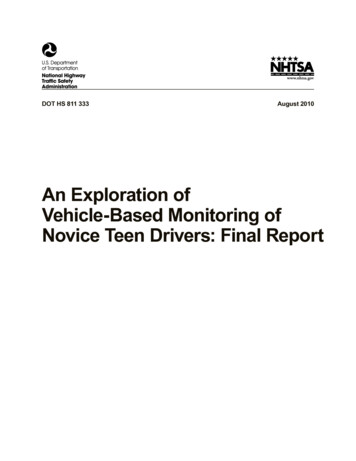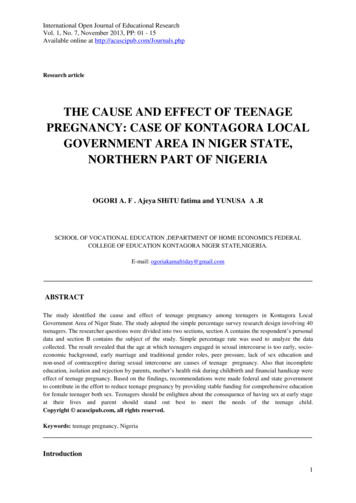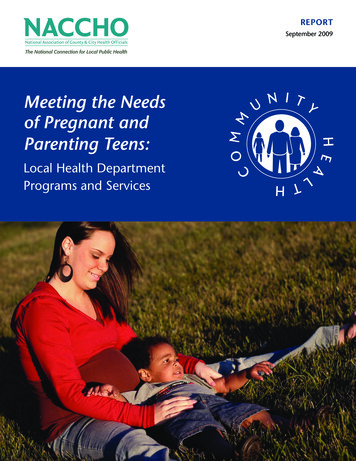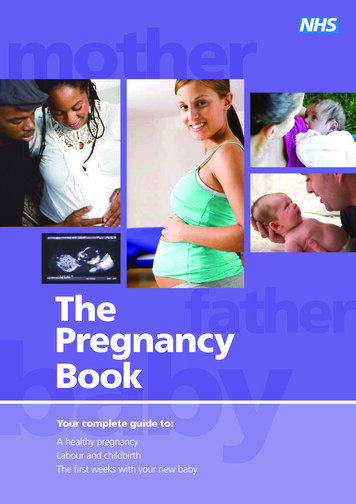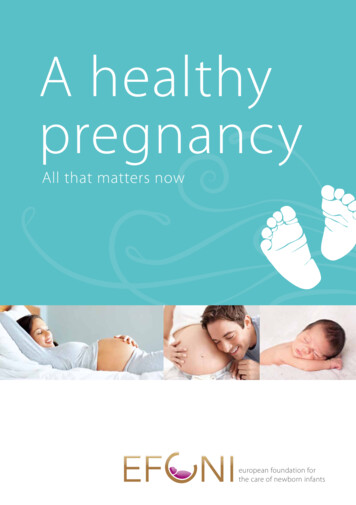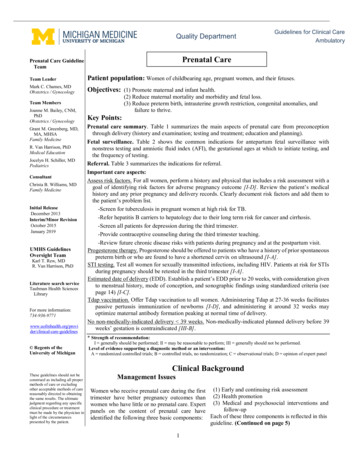
Transcription
Teen Pregnancy:Its Cost and Consequencesand what YOU can do to helpNCSL Fall ForumWashington, DCSarah Brown and Andrea KaneDecember 6, 2012What we’ll cover How are we doing in this area? Why Care?–Education–Workforce–Poverty–Budget What Can You Do?21
National Teen Birth Rates, 1940-2011Note: Birth data for 2011 is provisionalSources: Ventura, S.J., Mathews, T.J., & Hamilton, B.E. (2001). Births to Teenagers in the United States, 1940-2000.National Vital Statistics Reports, 49(10). Hyattsville, MD: National Center for Health Statistics.Retrieved from: http://www.cdc.gov/nchs/data/nvsr/nvsr49/nvsr49 10.pdfMartin, J.A., Hamilton, B.E., Ventura, S.J., Osterman, M.J.K., Kirmeyer, S., Wilson, E., & Matthews, T.J. (2012). Births: Final Data for 2010.National Vital Statistics Reports, 61(1). Hyattsville, MD: National Center for Health Statistics.Retrieved from http://www.cdc.gov/nchs/data/nvsr/nvsr61/nvsr61 01.pdfHamilton, B.E., Martin, J.A., & Ventura, S.J. (2012). Births: Preliminary Data for 2011. National Vital Statistics Reports, 61(5). Hyattsville, MD: National Center for Health Statistics.Retrieved from http://www.cdc.gov/nchs/data/nvsr/nvsr61/nvsr61 05.pdf3National Teen Pregnancy Rates, 1972-20084Source: Kost, K., & Henshaw S. (2012). U.S. Teenage Pregnancy, Births, and Abortions, 2008: National Trends by Age, Race and Ethnicity.New York: Guttmacher Institute. Retrieved from http://www.guttmacher.org/pubs/USTPtrends08.pdf2
Why does all this matter?What are the consequences:For the teen mom?For her child?For taxpayers?5Connection to poverty Poverty is both a cause and consequence of teenpregnancy About half of teen mothers live below the FPL As their children grow older, their likelihood of livingin poverty increases – in part because more of themha e mohavemoveded ooutt of their parents’ home63
The dropping out problem Nearly 1 in 4 U.S. public schoolt d t dropdhi h school.h lstudentsoutt off high Nearly 3 in 10 teen girls who drop outcite pregnancy or parenthood as a keyreason; for Hispanic and AfricanAmerican girls, it’s 4 in 10 One high school dropout costs thenation approximately 260,000 in lostearnings, taxes, and productively7Connection to education and workforcepreparation Onlyy 51% of teen moms getg a highg schooldiploma by age 22 vs. 89% of women withouta teen birth Only 38% of young teen moms (who havechildren before 18) graduate from high school. Fewer than 2% of teen mothers have a collegedegree by age 30.84
Connection to college completion 61% of women who have children after enrolling incommunityit collegellfailf il tot finishfi i h theirth i degree—adratet2/3 higher than the rate for those who didn’t havechildren 82% of students say that having a child while still inschool would make it harder to accomplish their goals NB: a college graduate will earn, on average, 1million more than a high school dropout9Connection to child welfare By age 19, 1/2 of girls who were in foster carebecome pregnant (about 2.5X more likely than thosenot in foster care) By age 21, 7 in 10 girls who were in foster carebecome pregnant and 1/2 of youngo ng men reportedgetting a girl pregnant105
Children of teen parentsToo-early pregnancy andparenthood also affects thefuture prospects of childrenof teen parents.11For example Compared to children born to older mothers (20-21yyears old),), children born to teen moms are more likelyyto:– start school at a disadvantage– drop out of high school– use Medicaid and SCHIP– experience abuse/neglect and enter the foster care system– end up in prison (sons)– be raised in single parent families– become teen parents themselves126
If you remember only one thing A child born to a teen mom who has not finishedhigh school and is not married is 9 times likelyto be poor than a child born to an adult who hasfinished high school and is married13Costs of teen childbearing in the US147
What can YOU do? Back to basics: there are only 2 ways to preventpregnancy– Less sex– More contraception Prevention must affect one or both of these goals And remember: The only teens getting pregnant arethose having sex and not using contraceptioneffectively15Some strategic advice Invest in approaches that have evidence ofsuccess Ask: what will lead to the most progressand/or have the biggest impact? Ask: what is my state/community likely tosupport? Enlist many sectors: businesses, faith, media,parents, teens, community groups 168
More advice Consider embedding TPP in other priorities(i.e. dropout prevention, child welfare,economic development) Set clear goals Use data to assess progress and stressaccountability Encourage those on the front lines Maybe use Aunt Sarah’s tips 17What programs work? Over 30 educational programs have beenrigorously evaluated and found to changeteens’ behavior A variety of approaches and settings BBodyd off evidenceidcontinuingti i tot grow throughthhcurrent federal grants189
Some State/Local Initiatives toconsider ArkansasAktaskk fforce andd ddata analysisl i South Carolina legislative task force New Mexico state and local goals WestW t VirginiaVi i i legislativel i l ti forumf19More Massachusetts foster care initiative West Virginia school superintendent/DHHRpartnership Many states/communities investing in effectiveyouth development approach – Teen OutreachProgram2010
More Mississippi–Blueprint for Economic Development–Governor made it a priority, created state taskforces, called for a plan–Local input–School districts decide on sex ed approach usingstate-approved list of programs21And finally California public/private investments multi-prong: education, health services, media,community grants, male involvement sustained through bipartisan administrations data driven: focus on hot spots dramatic declines in teen pregnancy/birth rates2211
Thank You!For more information check out:TheNationalCampaign.orgSign up for our e-gram atwww.thenationalcampaign.orgMy email: ssbrown@thenc.orgAndrea Kane’s email: akane@thenc.org12
-Education -Workforce -Poverty -Budget What Can You Do? 2. 2 National Teen Birth Rates, 1940-2011 Note: Birth data for 2011 is provisional Sources: Ventura, S.J., Mathews, T.J., & Hamilton, B.E. (2001). Births to Teenagers in the United States, 1940-2000. . BdBody ofid tii t th hf evidence continuing to grow through current .
